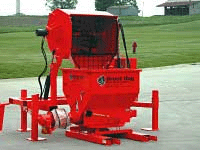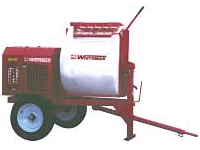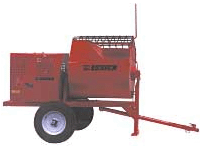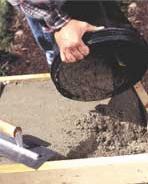Mortar Mixers: More Than a Tub on Wheels
By Tom Inglesby
 Every mason contractor has his or her own ideas about what makes the perfect mortar mixer. Here are some pointers from the both sides of the drum.
Every mason contractor has his or her own ideas about what makes the perfect mortar mixer. Here are some pointers from the both sides of the drum.
When we started out to examine what a mason contractor needed to look for in picking the best mortar mixer for his or her company, we thought we'd ask some of the vendors for a checklist. We contacted one of the largest companies ? Multiquip ? and one of the newest companies ? EZ Grout ? to find out what a contractor should know and why in picking a mixer. Then to get a counterpoint, we checked with an MCAA member mason contractor. Here is what we found.
"Mixing by hand is a thing of the past. There's no way a modern masonry contractor can compete without a motorized mortar mixer." So says Damian Lang, mason contractor ? Lang Masonry, Waterford, Ohio ? and entrepreneur. Lang is the head of EZ Grout, familiar to mason contractors as the "Grout Hog people."
Lang started EZ Grout to supply the industry he loves with equipment he felt it needed. Like Xerox, one piece of that equipment is now so ubiquitous that "Grout Hog" has almost become a generic for motorized high-lift grout delivery systems. The name just comes trippingly from the contractor's lips when talking about these tubs.
Lang recently turned his attention to the world of mortar mixers, turning out the Mud Hog. Based on his own experiences as a contractor, Lang says, "It's impossible to operate at a profit without a good, dependable mixer. I don't know any mason contractor that's mixing by hand anymore. Every mason contractor can relate to that."
And Lang says that the size of the company doesn't matter, even the size of the average job doesn't matter. "It doesn't make any difference. You just can't do it. If you're a mason contractor, you're going to be mixing 10 to 15 bags a day. If you're going to mix more than 1 bag of mortar, you need a mixer. It's that important. People used to mix by hand on the smaller jobs, but that's over with. If they don't have a mixer they can rent one cheaper than paying for the labor."
Speaking of renting, isn't that a better option than owning, especially for the low-volume contractor? As one who wants to sell you a mixer, we expected Lang to frown on renting. We were right. "You can rent a mixer, but a mixer is something that a contractor needs on an ongoing basis. To rent it is just not feasible. You'll save the price of a new one in a few months compared to renting. If a mixer is built right, it should run for five years plus. If it is well maintained and used right, a mixer can last 10 years plus."
Even Lang agrees that when the volume goes up, then renting fill-in equipment makes sense. Few contractors in this economy can keep enough gear in their yard to cover all possible workloads. Warren Faler of Multiquip, Carson, Calif., says that a rental yard is one of the best places to store equipment you might need ...but might not. "We all hope to get more work than we can handle," he admits, "but don't want to carry the cost of stocking equipment for those high times. Yes, every contractor needs a mixer 'on the payroll' but just like you add temporary labor, you can add a temporary mixer when you have more work than you expected."
 Another factor, Faler believes, is the capability of the contractor to maintain the equipment. He explains, "Contractors often don't have mechanics on the job or workers capable of repairing equipment that breaks down in use. Sometimes you find yourself moving mixers from job to job without taking them down for scheduled maintenance. You might see something wrong but put off doing anything about it until the job is over, then ship the mixer to another job right away and never fix the problem. Frayed V-belts, shaking bearings, loose parts might be overlooked because you can't afford to take the equipment out of service. A rental agent would be able to swap out the problem machine for a well-maintained unit, even delivering it to the jobsite for you on short notice."
Another factor, Faler believes, is the capability of the contractor to maintain the equipment. He explains, "Contractors often don't have mechanics on the job or workers capable of repairing equipment that breaks down in use. Sometimes you find yourself moving mixers from job to job without taking them down for scheduled maintenance. You might see something wrong but put off doing anything about it until the job is over, then ship the mixer to another job right away and never fix the problem. Frayed V-belts, shaking bearings, loose parts might be overlooked because you can't afford to take the equipment out of service. A rental agent would be able to swap out the problem machine for a well-maintained unit, even delivering it to the jobsite for you on short notice."
There are currently three basic styles of mortar mixer for contractors based on type of power drive. The complexity of the drive is one of the telling features that separate the low-cost, entry-level machine from the long-term investment. The three power transfer types are:
V-belt/open gear - The least expensive system and the easiest to repair on the job. That's good because they tend to break more often. "These are the most popular, especially for small-to-medium sized contractors," claims Faler. "But the gears are subject to contamination if proper cleaning is not done and regular maintenance is overlooked. V-belts stretch and turn if the unit is overloaded with material."
Enclosed gearbox - Provides longer service with less maintenance. These are designed to mix larger or stiffer loads than a V-belt unit. According to Faler, "These are the high production units that can supply a large crew or pump. They are more reliable and less subject to contamination. The only wear parts are the sheer pin and clutch. Of course, they cost more than the V-belt model."
Hydraulic - The crown jewels of the mortar trade, hydraulic mixers are the most efficient, have literally no wear parts, and can usually mix the largest loads. Both Lang and Faler agree that this is the ultimate machine. Lang, whose new mixer is a hydraulic unit, says, "In the next 10 years, all the larger contractors will be going to hydraulic mixers. If it plugs up, you can reverse it and it will unplug itself. If you're using a belt driven mixer and it plugs up, you have your crew shut down for a half hour while they shut the mixer down, dig it out with shovels, and restarts it. One plug up can cost you $400 to $500 right on the spot. If you figure the loss of production, you can get up to $1,000 in losses very quickly. For the larger masons I would highly recommend the hydraulic mixer."
Scott Mosher of Key Masonry, Duluth, Ga., nods in agreement. "The first and foremost quality I look for in a mixer is durability and the hydraulic unit has that over all the others. The other thing I believe makes a big difference is the power unit: always go for the gasoline powered mixer."
While the gasoline engine is the standard for larger mixers, many companies offer electric as well as gasoline power sources on small-to-medium mixers. Even with gasoline, picking the right engine can be anything but standard. Some contractors are dead set for or against a particular engine brand for reasons of personal experience. Many vendors will supply different brands on the same model mixer to accommodate those with such strong feelings. "Our sales show a preference for Honda engines, followed by Briggs & Stratton, then electric motors," says Faler. Usually, however, the biggest choice is in horsepower, not brand of the engine.
Faler's rule of thumb for engines is simple: Get more than you think you'll ever need. "Always pick the highest horsepower engine you can afford. That way, when you're on the job, it will be able to handle whatever comes along. You won't have to check ratings to see if you can use a particular mix or size gravel ? up to the size specified for the drum and blades, of course."
He adds, "Also watch for the engine cover or cowling, be sure it allows ample ventilation to reduce engine wear and increase performance while keeping dirt and cement dust off internal parts. It has to be heavy enough to resist vibration and be non-steel or coated to prevent rusting."
Any mechanical device has its upper limits of operation. Usually called ratings, these factors tell the contractor what the equipment can and can't do under given conditions. But while the mixer might be sold to do a certain job, and rated for that job, there is no way for the manufacturer to keep workers from asking more of the equipment. In other words, people sometimes use equipment for tasks it was never designed to do.
"In California, for some reason, it seems most mason contractors use cement mixers for everything," notes Faler. "That's not a good idea when you're mixing mortar ? the turning drum type cement mixer won't give you the same thorough consistency as a real mortar mixer which uses blades turning inside the drum."
And regardless of the location, workers tend to try adding just a little more mix to speed up the production and soon overloading occurs. That's when the choice of higher power and hydraulic operation comes in handy. Again, a rule of thumb for mixing capacity, as Faler puts it, is one bag of mix equals three to four cubic feet of mortar mix or, if you are still doing it by hand, 16 shovels of sand and 4 shovels of cement. So an 8-cu. ft. mixer would be rated at 2 to 2.5 bags.
"Our studies show if you have over 10 men on a job, the mixer should be a minimum of a three-bag mixer," claims Lang. "If not, it can't keep up with the men. If your crew is four or five men, you can go to a two-bagger. If you choose a larger hydraulic mixer, you only have to have one mixing station for the whole job site."
 Addressing the "one mixer for everything" idea, Lang adds, "The question is, will you be using your mixer to mix grout. If you do, the mixer will need to be larger and it will have to be hydraulic. Hydraulic mixers will mix pea gravel grout, something that many mason contractors are not aware of. They're still using the old drum type mixers that take about three times longer to mix thoroughly. Hydraulic mixers will mix grout and if they happen to get plugged on a rock, you simply reverse it and then run it forward to clear the plug."
Addressing the "one mixer for everything" idea, Lang adds, "The question is, will you be using your mixer to mix grout. If you do, the mixer will need to be larger and it will have to be hydraulic. Hydraulic mixers will mix pea gravel grout, something that many mason contractors are not aware of. They're still using the old drum type mixers that take about three times longer to mix thoroughly. Hydraulic mixers will mix grout and if they happen to get plugged on a rock, you simply reverse it and then run it forward to clear the plug."
Some other concerns surface when you think about the daily use of the mixer. Take the drum for example. Short, deep drums are most efficient because the mortar is carried from end-to-end quicker. That means better mixing faster. And a narrow dump chute is recommended so you can dump into a wheelbarrow from its front or side.
It probably goes without saying, but a thicker drum will take more abuse and wear without failing. Steel, still the most popular drum material, should be lap-welded not butt-welded.
Coming on strong is the "plastic drum" mixer. Polyethylene tubs are easy to clean of dried material, are as abrasion resistant as steel, don't dent like steel, and resist chemical corrosion and rust. Mosher sees these as valuable traits, "Mortar mixers must be easy to clean, both the inside the drum and the paddles that rotate the mortar because they have to be cleaned every day. The easier, the faster, the better it is at the end of a day or end of the job."
Those paddle arms and blades should be pitched at a 30-to-40 degree angle, says Faler. "That will create a fast, uniform mix and reduce material loss due to splashing."
And splashing is a problem, indicates Lang. "There should be more blade where it cuts the mortar so they don't slap it and splash it all over the place. In a good mixer, the blades are more upright, and they cut through the mortar instead of tumbling it."
Lang won't make too many friends with weekend golfers when he relates, "My test is to toss a golf ball inside the mixer when it's running empty. If it's been designed properly, that golf ball will go from one side of the mixer drum clear to the other, and then back. That means that mortar will be tumbled back and forth. If the mixer's not designed properly, that golf ball will stay at one end or the other, and that means you won't get a thorough mix."
Steel or Neoprene? The choice of blade material is up to the contractor but two factors might help make that choice: Steel blades last longer on average but, with proper clearance settings, neoprene blades prevent material build-up better. Still, neoprene blades generally have to be replaced more often than steel, a cost factor.
A big maintenance expense is keeping the bearings in good condition. "Water and cement wear away shaft components and reduce their life dramatically," comments Faler. "The standard grease-fitting equipped paddle shaft bearings require periodic attention, grease under pressure applied to the fitting to push out material that has seeped by the seals."
Multiquip's Essick division offers a sealed system that requires no greasing, is extremely durable, and is "great for contractors who don't maintain their mixers," as Faler says.
Lang's new Mud Hog also uses sealed bearings for the same reasons. Another design feature that Lang worried about is ease of seal and bearing replacement. "In a mixer, the shaft should be supported from the outside, where the bearings are not up against the tub. If the bearings are up against the tub and the shaft starts wearing out right where it supports the weight, that shaft is going to wobble. The old mixers were famous for that."
He continues, "You need a system where you can change the bearings and seals without taking the drum off the mixer. It's about a half hour job. To change the seals in most mixers, it could be a half-day job for a mechanic. The mixer we're building is like the Essick's where the seals can be changed in no more than 45 minutes."
A final point: don't forget, you have to load, unload and move that mixer.
Give some thought to your workers in loading and unloading the mortar mix. According to Lang, his mixer offers the worker some decided benefits. In fact, that was why he got into that business in the first place. "Our unit discharges high, but you load the thing down low. There's no more lifting heavy bags of mortar and concrete up above your chest. With our mixer, you throw them in at waist height. There's no more shoveling high in the air. This is stuff I've been trying to get the mixer companies to do for years. Nobody would listen to me, so I decided we'll build our own."
As for moving the mixer, Faler says, "If highway towing is standard for your mixers, larger tires will provide less bounce and leaf springs will reduce wear and tear due to vibration. And be sure the tow bar is strong enough ? the stronger the bar, the safer the tow."
Mosher considers the mixer's wheels and tires, too, but in a different way. "It should be easy to remove the tire hub to enable a forklift to have better access to the mixer. In addition, I want to be able to remove a tire from a mixer easily so that it is very difficult to steal that unit."
Now that is a very practical issue considering the high cost of equipment insurance. Interesting, ease of removing the wheels never came up in talking to the manufacturers. Wonder if they ever thought of it?
Then again, Lang's Mud Hog doesn't even have wheels. It's designed to sit on a pickup truck bed and be offloaded by forklift. So maybe at least one other contractor ? and manufacturer ? has thought about the problem of theft.
Something Totally Different
 If you get a call for a repair job that requires a small amount of mortar mixed on the site, do you hook up the mixer to the truck? Grab the shovels and mortar box? Get a pail?
If you get a call for a repair job that requires a small amount of mortar mixed on the site, do you hook up the mixer to the truck? Grab the shovels and mortar box? Get a pail?
Maybe the folks at Quikrete, Atlanta, Ga., have a better idea. While sold for the do-it-yourself market, their Concrete and Mortar Mixer might be the better idea for your truck's toolbox.
The mixer is designed to stir up to 80 pounds of concrete without the use of strenuous stirring in a wheelbarrow or mortar box. To use, you pour concrete mix and water in the cylindrical mixer, hand-tighten the lid, lay it on its side and roll in a full circle.
Upon completing one full circle, sit the mixer upright, roll it onto its lid and back again. Repeat the process until you have rolled the mixer bucket through three complete circles. Simply open the lid of the mixer bucket and pour the mixed product into your project.
Not rocket science but then again, simple usually means easier and that's not bad. Besides, it fits easily in the back of the truck, doesn't need gasoline or an extension cord and ? dare we say it ? seems like a fun way to mix mortar in small batches.
About the Author
Tom Inglesby is a San Diego-based freelance writer whose work has appeared in numerous online and print publications. He is the winner of the Construction Writers Association's 2002 Boger Award for Special Reports.


















